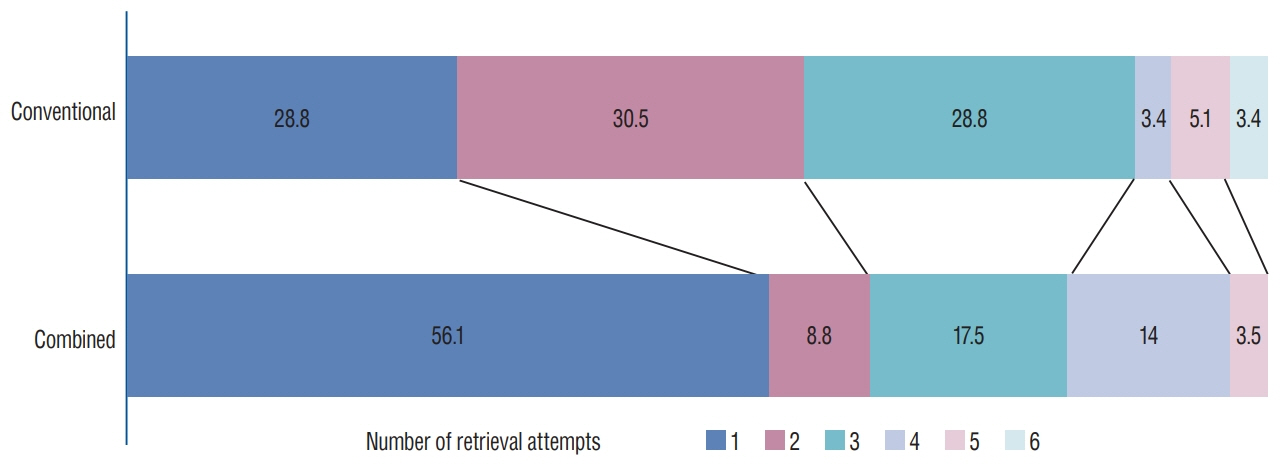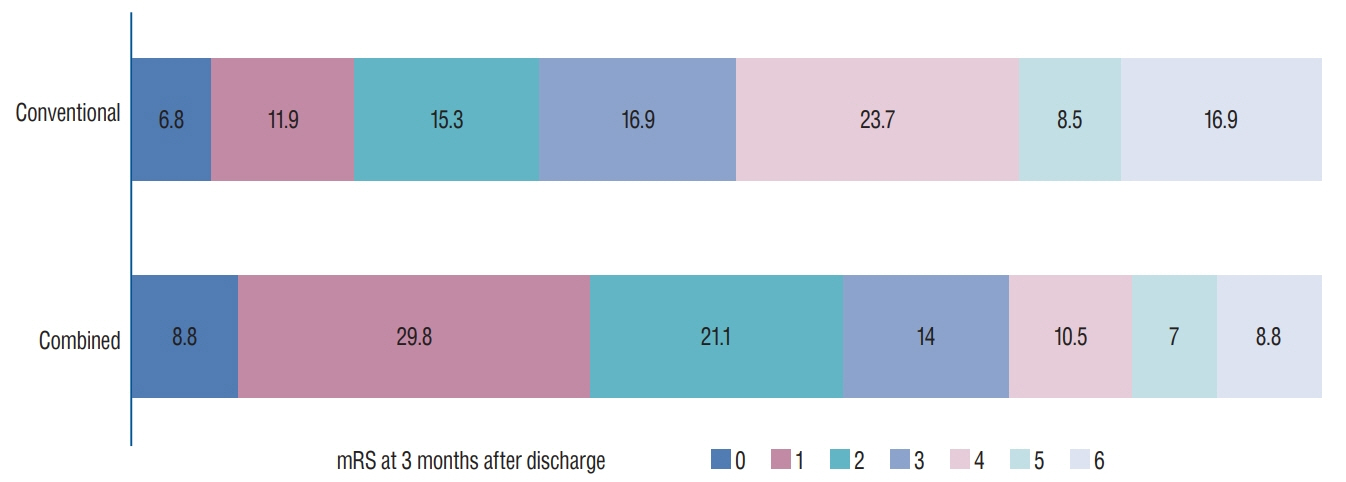J Korean Neurosurg Soc.
2019 Jul;62(4):405-413. 10.3340/jkns.2019.0007.
Efficacy of Combining Proximal Balloon Guiding Catheter and Distal Access Catheter in Thrombectomy with Stent Retriever for Anterior Circulation Ischemic Stroke
- Affiliations
-
- 1Busan-Ulsan Regional Cardiocerebrovascular Center, Dong-A University Hospital, Busan, Korea. nschoi1018@dau.ac.kr
- 2Department of Neurosurgery, Dong-A University Hospital, Dong-A University College of Medicine, Busan, Korea.
- 3Department of Radiology, Dong-A University Hospital, Dong-A University College of Medicine, Busan, Korea.
- 4Department of Neurology, Dong-A University Hospital, Dong-A University College of Medicine, Busan, Korea.
- KMID: 2463671
- DOI: http://doi.org/10.3340/jkns.2019.0007
Abstract
OBJECTIVE
We evaluated efficacy of combining proximal balloon guiding catheter (antegrade flow arrest) and distal access catheter (aspiration at the site of occlusion) in thrombectomy for anterior circulation ischemic stroke.
METHODS
We retrospectively analyzed 116 patients who underwent mechanical thrombectomy with stent retriever. The patients were divided by the techniques adopted, the combined technique (proximal balloon guiding catheter and large bore distal access catheter) group (n=57, 49.1%) and the conventional (guiding catheter with stent retriever) technique group (n=59, 50.9%). We evaluated baseline characteristics (epidemiologic data, clinical and imaging characteristics) and procedure details (the number of retrieval attempts, procedure time), as well as angiographic (thrombolysis in cerebral infarction (TICI) score, distal thrombus migration) and clinical outcome (National Institutes of Health Stroke Scale at discharge, modified Rankin Scale [mRS] at 3 months) of them.
RESULTS
The number of retrieval attempts was lower (p=0.002) and the first-pass successful reperfusion rate was higher (56.1% vs. 28.8%; p=0.003) in the combined technique group. And the rate of final result of TICI score 3 was higher (68.4% vs. 28.8%; p<0.01) and distal thrombus migration rate was also lower (15.8% vs. 40.7%; p=0.021) in the combined technique group. Early strong neurologic improvement (improvement of National Institutes of Health Stroke Scale ≥11 or National Institutes of Health Stroke Scale ≤1 at discharge) rate (57.9% vs. 36.2%; p=0.02) and favorable clinical outcome (mRS at 3 months ≤2) rate (59.6% vs. 33.9%; p=0.005) were also better in the combined technique group.
CONCLUSION
The combined technique needs lesser attempts, decreases distal migration, increases TICI 3 reperfusion and achieves better clinical outcomes.
Keyword
MeSH Terms
Figure
Cited by 1 articles
-
Can Transradial Mechanical Thrombectomy Be an Alternative in Case of Impossible Transfemoral Approach for Mechanical Thrombectomy? A Single Center's Experience
Hyun Wook Cho, Hyo Sub Jun
J Korean Neurosurg Soc. 2021;64(1):60-68. doi: 10.3340/jkns.2020.0240.
Reference
-
References
1. Chueh JY, Kühn AL, Puri AS, Wilson SD, Wakhloo AK, Gounis MJ. Reduction in distal emboli with proximal flow control during mechanical thrombectomy: a quantitative in vitro study. Stroke. 44:1396–1401. 2013.
Article2. Chueh JY, Puri AS, Wakhloo AK, Gounis MJ. Aspiration efficacy of suction catheter in the management of distal embolization during interventional treatment of acute ischemic stroke. J Neurointerv Surg. 6(Suppl 1):A1–A78. 2014.3. Chueh JY, Puri AS, Wakhloo AK, Gounis MJ. Risk of distal embolization with stent retriever thrombectomy and ADAPT. J Neurointerv Surg. 8:197–202. 2016.
Article4. Fargen KM, Arthur AS, Spiotta AM, Lena J, Chaudry I, Turner RD, et al. A survey of neurointerventionalists on thrombectomy practices for emergent large vessel occlusions. J Neurointerv Surg. 9:142–146. 2017.
Article5. Goyal M, Demchuk AM, Menon BK, Eesa M, Rempel JL, Thornton J, et al. Randomized assessment of rapid endovascular treatment of ischemic stroke. N Engl J Med. 372:1019–1030. 2015.
Article6. Goyal M, Menon BK, van Zwam WH, Dippel DW, Mitchell PJ, Demchuk AM, et al. Endovascular thrombectomy after large-vessel ischaemic stroke: a meta-analysis of individual patient data from five randomised trials. Lancet. 387:1723–1731. 2016.
Article7. Higashida RT, Furlan AJ, Roberts H, Tomsick T, Connors B, Barr J, et al. Trial design and reporting standards for intra-arterial cerebral thrombolysis for acute ischemic stroke. Stroke. 34:e109–e137. 2003.
Article8. Kang DH, Park J. Endovascular stroke therapy focused on stent retriever thrombectomy and direct clot aspiration: historical review and modern application. J Korean Neurosurg Soc. 60:335–347. 2017.
Article9. Kerr DM, Fulton RL, Lees KR, VISTA Collaborators. Seven-day NIHSS is a sensitive outcome measure for exploratory clinical trials in acute stroke: evidence from the Virtual International Stroke Trials Archive. Stroke. 43:1401–1403. 2012.
Article10. Kleine JF, Wunderlich S, Zimmer C, Kaesmacher J. Time to redefine success? TICI 3 versus TICI 2b recanalization in middle cerebral artery occlusion treated with thrombectomy. J Neurointerv Surg. 9:117–121. 2017.
Article11. Linfante I, Starosciak AK, Walker GR, Dabus G, Castonguay AC, Gupta R, et al. Predictors of poor outcome despite recanalization: a multiple regression analysis of the NASA registry. J Neurointerv Surg. 8:224–229. 2016.
Article12. Mokin M, Ionita CN, Nagesh SV, Rudin S, Levy EI, Siddiqui AH. Primary stentriever versus combined stentriever plus aspiration thrombectomy approaches: in vitro stroke model comparison. J Neurointerv Surg. 7:453–457. 2015.
Article13. Mueller-Kronast NH, Zaidat OO, Froehler MT, Jahan R, Aziz-Sultan MA, Klucznik RP, et al. Systematic evaluation of patients treated with neurothrombectomy devices for acute ischemic stroke: primary results of the STRATIS registry. Stroke. 48:2760–2768. 2017.14. Nguyen TN, Malisch T, Castonguay AC, Gupta R, Sun CH, Martin CO, et al. Balloon guide catheter improves revascularization and clinical outcomes with the solitaire device: analysis of the North American Solitaire Acute Stroke Registry. Stroke. 45:141–145. 2014.15. Oh JS, Yoon SM, Shim JJ, Doh JW, Bae HG, Lee KS. Efficacy of balloonguiding catheter for mechanical thrombectomy in patients with anterior circulation ischemic stroke. J Korean Neurosurg Soc. 60:155–164. 2017.
Article16. Powers WJ, Derdeyn CP, Biller J, Coffey CS, Hoh BL, Jauch EC, et al. 2015 American Heart Association/American Stroke Association focused update of the 2013 guidelines for the early management of patients with acute ischemic stroke regarding endovascular treatment: a guideline for healthcare professionals from the American Heart Association/American Stroke Association. Stroke. 46:3020–3035. 2015.
Article17. Velasco A, Buerke B, Stracke CP, Berkemeyer S, Mosimann PJ, Schwindt W, et al. Comparison of a balloon guide catheter and a non-balloon guide catheter for mechanical thrombectomy. Radiology. 280:169–176. 2016.
Article18. Young FB, Weir CJ, Lees KR, GAIN International Trial Steering Committee. Comparison of The National Institutes of Health Stroke Scale with disability outcome measures in acute stroke trials. Stroke. 36:2187–2192. 2005.
Article
- Full Text Links
- Actions
-
Cited
- CITED
-
- Close
- Share
- Similar articles
-
- Effectiveness of Anchoring with Balloon Guide Catheter and Stent Retriever in Difficult Mechanical Thrombectomy for Large Vessel Occlusion
- Efficacy of Balloon-Guiding Catheter for Mechanical Thrombectomy in Patients with Anterior Circulation Ischemic Stroke
- Forced Arterial Suction Thrombectomy Using Distal Access Catheter in Acute Ischemic Stroke
- Suction thrombectomy of distal medium vessel occlusion using microcatheter during mechanical thrombectomy for acute ischemic stroke: A case series
- Aspiration-Retriever Technique for Stroke with Large Bore Intermediate Catheter : A Single Center Experience




